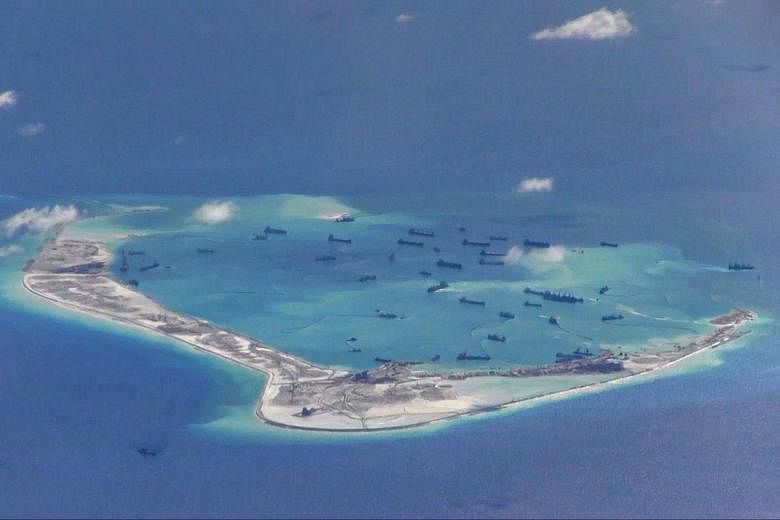Last week's Nobel prizes in physics and chemistry were models of global cooperation, recognising elite international teams of scientists for their work on gravitational waves and electron microscopy. The awards showed that major research breakthroughs typically require breaking down national borders.
But the same is true in the field of science diplomacy, where much greater international cooperation on scientific research can help to fix pressing geopolitical problems around Asia.
Science can underpin breakthroughs in international relations, not least in sensitive areas where other methods have failed. Working across borders, scientists identify common problems and open up new avenues when "sacredness and taboo can confound the best-laid plans of national deal-makers", in the words of author Steven Pinker.
One celebrated example came with the 2015 agreement to limit Iran's nuclear programme. The deal was pushed by United States Energy Secretary Ernest Moniz and his Iranian counterpart Ali Akbar Salehi, both of whom studied at MIT in the 1970s. Their relationship of trust followed a rich tradition of scientists involved in nuclear non-proliferation talks.
Climate change is another. Despite US President Donald Trump's decision to pull out of the Paris treaty, scientific evidence has pushed nearly all other nations to address this issue. The International Panel for Climate Change, a science-driven organisation, established the facts upon which the Paris accord was constructed.
There are myriad other examples of global problems that cannot be solved without serious scientific input. From the management of oceans to the spread of lethal disease and weapons of mass destruction, the world's major challenges are beyond the capabilities of any single nation to address alone.
These are issues where scientists can build consensus and identify answers by building trust through new networks of cooperation, which then pave the way for solutions to be adopted by politicians. Where trust exists, diplomacy can be successful.
Science can also be a geopolitical bridgehead through new science-based organisations, including those that become templates for the management of "ungoverned" spaces.
The rules that control the Internet are one example, as is the case of Antarctica, where many regulations stem from earlier scientific missions.
The problem is that while scientific research is increasingly global, its potential is still not consistently exploited to address major challenges, especially in Asia.
National investment in multilateral scientific efforts to address global challenges such as climate change or health epidemics is patchy. Regional research capacity under Asean is almost non-existent. The international mobility of scientists is not helped by national rules.
If progress could be made on these fronts, stronger scientific networks could help to make progress on many Asian flashpoints.
One example are the frictions caused by trans-border aquifers, such as the Mekong, Brahmaputra and Amu Darya rivers. These often cause tensions between regional powers, not least China and India. Lack of trust could plausibly be alleviated by common scientific understanding of the rivers' condition.
The same is true for disputes over oceans. While China's island-building projects in the South China Sea grab the most attention, there are many underlying problems - from overfishing to preserving coral reefs - where scientific cooperation could underpin future diplomacy.
There is a wider opportunity for Asean too, as it moves to bring its 10 members closer together.
Here, the European Union can provide a model, with its rich history of science-mediated international relations. The EU runs an €11 billion (S$17.6 billion) flagship programme called Horizon 2020, which brings scientists together from around the world and welcomes global partners to any collaborative research project. This scientific cooperation has often been institutionalised too, as with the launch of the Cern research centre in the 1950s - a peace project that now brings together scientists from 31 countries.
Europe's multilateral model can have dramatic results too. In the fight against the Ebola virus in early 2015, the EU mobilised $225 million within weeks, contributing to all three of the vaccines in existence today.
So what should be done in Asia?
First, governments must redouble efforts to promote international scientific collaboration.
National funding for science is rising around the region. This is welcome. But stronger regional joint-funding schemes are also needed, such as a new scheme that is being piloted between several South-east Asian countries and Europe.
National research programmes should also do more to help scientists join high-quality international consortia, as part of wider attempts to support multilateral global institutions. Such investments in global science and innovation can be a critical step for South-east Asian economies seeking to break out of the middle-income trap.
Second, governments should systematise the use of scientific advice, not just in policy areas like energy and public health, but also in foreign and social policies, for instance through the creation of chief scientist positions or committees. This is already at an advanced stage in some countries, including Singapore, but progress is uneven.
Third, scientific exchange programmes can build new cross-country links, especially regional programmes that are also open to scientists from around the world, like the Marie Curie fellowships in Europe.
Asean's Talent Mobility programme, launched in 2013, is a step in the right direction, but much more can be done. If money and political will can be found to make such programmes a success, science diplomacy can become a powerful force to bind Asia and its people closer together.
•Dr Kostas Glinos is visiting EU Fellow at the Lee Kuan Yew School of Public Policy, National University of Singapore.
•James Crabtree is senior fellow at the Centre on Asia and Globalisation at the school.

